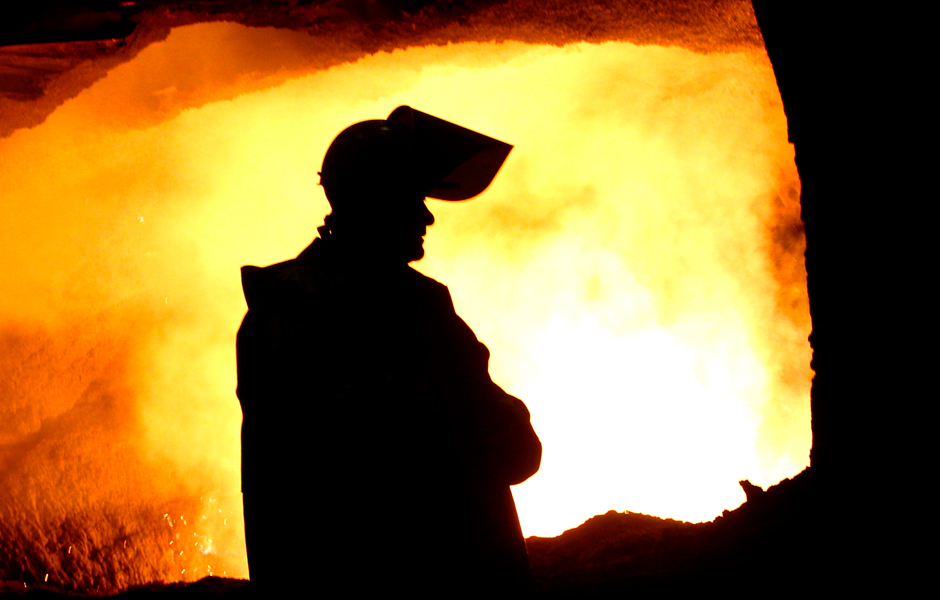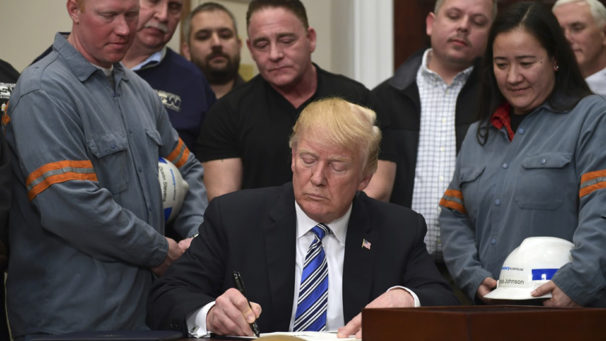
President Donald Trump’s imposition of steel and aluminum tariffs has sparked debate among labor leaders, union activists, and progressives. Questions about the effectiveness of the tariffs as a policy and about Trump’s political motivations have resulted in a variety of opinions. The article below is one of several analyses and commentaries that People’s World will publish on the topic. The views represented here are those of the author.
Just like the retailers and manufactures who dutifully awarded one-time bonuses to employees immediately after the passage of the GOP tax cut bill, Republic Steel lined up to play its part last week following Trump’s imposition of new tariffs on imported steel and aluminum. In a move so smooth it could have been scripted by a public relations wizard, within hours of Trump signing off on the hefty new import taxes, the Canton, Ohio-based company announced it would again fire up its plant in Lorraine and create 1,000 new jobs.
Republic fulfilled its role in Trump’s political PR game, but it wasn’t the only one. Some critics argue there are a few in the labor movement, as well as some Democratic politicians, who have also been a little too eager to join the chorus.
They point to figures like United Steelworkers (USW) International President Leo Gerard, who said that Trump’s tariff decision “aligns with what every citizen knows: these products are vital to our national security.” He was echoing Trump’s official rationale for the new duties: that U.S. steel is vital to production of U.S. war machines.
Noting another aspect of the pro-tariff argument, Sen. Sherrod Brown of Ohio praised Trump, saying, “This welcome action is long overdue for shuttered steel plants across Ohio and steelworkers who live in fear that their jobs will be the next victims of Chinese cheating.”
For the Steelworkers and the Democrats that they have long backed, the embrace of the White House’s latest move is being spun as a sort of “getting what we can out of Trump” tactic. To be sure, there is substance to the claim; it’s not like the USW is enlisting in the Trump army lock, stock, and barrel. Gerard says the tariffs are “only one of the many issues” his members care about, and, indeed, at the same time that the union is lauding Trump’s tariffs, it is also working hard to block his guy, right-to-work Republican Rick Saccone, from winning a Congressional seat in Pennsylvania’s steel country.
Gerard, Brown, and others have been put into a tough spot, and that’s exactly where Trump wants them. He has signaled he’s willing to adopt portions of their agenda on trade—an agenda which for so long has been spurned by the free trade mantra that dominates the leadership of both of the mainline political parties. How could they not express some satisfaction and even grudging acknowledgement of Trump’s efforts?
When Leo Gerard says, “For too long, our political leaders have talked about the problem but have largely left enforcement of our trade laws up to the private sector,” he’s absolutely right. For decades, workers (and not just those in the U.S.) have been hung out to dry as globalization proceeded apace with only minimal efforts made to help them navigate the transition of industrial and technological change.
Shareholder interests alone have dominated the economic conversation and shaped trade agreements. The need for a not just fairer trade, but for a smarter and more cooperative international regulatory regime has been apparent to unions and progressive economists for a long time.
However, can protectionism—which is really what these tariffs amount to—save the day for steel? And even if tariffs were a part of the solution to the woes of unfair trade and abusive labor practices overseas, is what Trump’s proposing actually going to help?
It is estimated that a maximum of 140,000 people are directly employed in the steel industry in the United States, though some estimates put the number closer to 90,000. It is these workers—and even more so their bosses in the Steel Manufacturers Association—who are the supposed beneficiaries of any ramping-up of U.S. steel production. They’ll have greater job security, and new jobs will be created as plants like the one in Lorraine come back on-line.
But citing figures from the Commerce Department, automakers and major industrial equipment manufacturers claim that 6.5 million Americans are employed in downstream manufacturing industries that consume steel and aluminum—including cars, aircraft, aluminum cans and other products, pipe manufacturing, and building materials. As tariffs bump up the price of the metals their industries rely on, they argue that the country may actually end up losing jobs.
It’s a bit of whom do you believe: this capitalist or that one? But there are reports suggesting that when George W. Bush implemented steel tariffs in 2002, as many as 200,000 jobs were lost in downstream industries—a number greater than the size of the entire U.S. steel-producing workforce at the time.
All that to say, it is not at all clear that Trump’s tariffs will be a net gain for U.S. workers. They may arguably be a boon to steel workers, but whether the total job impact will be positive is debatable. And even for steel workers, the long-term outlook is not assured; Bush’s tariffs slowed the decline in the number of U.S. steel jobs, but only temporarily.
As for the national security argument? Totally bogus.
Under a 1933 law, the Pentagon is required to give preferential treatment to domestic suppliers of steel and aluminum construction materials UNLESS the country’s producers cannot meet demand. Even with the most massive military machine on Earth, the Pentagon currently only consumes 3 percent of U.S.-made steel and aluminum. Over two-thirds of all steel used in the United States is still domestically produced, so there is absolutely zero chance that America would be unable to meet its metal needs in case of a war. But national defense is always a go-to argument when you want to stop a policy debate.
So how about the dumping claim—the oft-repeated desire to stop China from flooding the U.S. market with cheap steel? China now accounts for nearly half of global steel production, and without doubt that country’s production has pushed down the international price for the metal. But the China-bashing that Trump and his entourage (and some union leaders) engage in just doesn’t hold up when you look at the numbers.
Producing a tiny 2.4 percent of the raw steel consumed in the U.S., China doesn’t even make the top-ten list of foreign importers. All the talk of stopping Chinese dumping is a political show staged by Trump. He is pitting worker against worker, both domestically and internationally. Chinese workers are not the problem. Chinese steel is not the problem. Policies that force workers to compete on wages and investment decisions made for private economic interests rather than social benefit are the problem.
Trump is already looking ahead to the midterm elections and, even further, to 2020. The tariffs are not just a manifestation of the economic nationalist outlook that he has spouted for decades; they are also a part of a strategy to hold onto and expand upon the 43 percent of union households who voted for him in 2016.
If he is to maintain his advance into former Democratic strongholds like Michigan, Pennsylvania, Ohio, and Wisconsin, he knows that driving a wedge into organized labor is a necessity. And tariffs may be just the thing that will do the trick. As for the rest of the Republican Party, the ideological blinders of free trade (and campaign contribution checks) are forcing many to keep their distance from Trump, even though there could be some electoral gain for them.

Trump is hoping that Leo Gerard is correct when he says it will be “very hard” for union steelworkers to forget what Trump has done for them when it comes time to head to the voting booth. That is precisely the calculation that Trump is making with these tariffs. It is a dangerous game for unions and liberal politicians, but given their constituencies’ demands and the fact that a president is finally calling for some of the things they’ve been demanding for a generation, their options are limited.
Labor and progressives should be cautious of anything Trump puts on the table; he’s not thinking of their interests with any of his proposals—these tariffs included.
As for the long-term way out, the dilemma brings to mind the words of Frederick Engels from some 130 years ago: “Protection is at best an endless screw, and you never know when you have done with it. By protecting one industry, you directly or indirectly hurt all others, and have therefore to protect them too. By so doing, you again damage the industry that you first protected, and have to compensate it; but this compensation reacts, as before, on all other trades, and entitles them to redress, and so on ad infinitum.”
There is no easy answer to the problems of unfair trade, but knee-jerk protectionism is not likely to be part of it.










